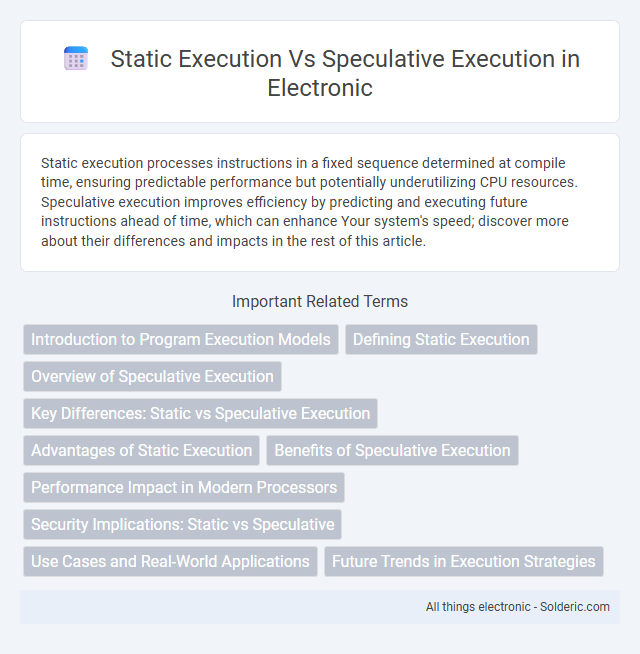Static execution processes instructions in a fixed sequence determined at compile time, ensuring predictable performance but potentially underutilizing CPU resources. Speculative execution improves efficiency by predicting and executing future instructions ahead of time, which can enhance Your system's speed; discover more about their differences and impacts in the rest of this article.
Comparison Table
| Aspect | Static Execution | Speculative Execution |
|---|---|---|
| Definition | Execution based on predetermined instruction order without prediction. | Execution that guesses future instructions to improve performance. |
| Prediction | No prediction of branches or instructions. | Uses branch prediction and heuristics to speculatively execute. |
| Performance | Slower due to waiting for actual instruction flow. | Faster by executing instructions ahead of time. |
| Complexity | Simple control logic and pipeline design. | Complex control logic with rollback and validation mechanisms. |
| Risk | Minimal risk of incorrect execution. | Risk of misprediction leading to pipeline flush and wasted cycles. |
| Use Case | Embedded systems, real-time applications with strict predictability. | High-performance CPUs for general-purpose computing. |
| Example CPUs | Simple RISC processors. | Intel Pentium 4, modern Out-of-Order CPUs. |
Introduction to Program Execution Models
Static execution follows a rigid, predetermined sequence of instructions based on compile-time analysis, ensuring predictable program behavior and simpler hardware design. Speculative execution predicts potential instruction paths to utilize idle CPU resources and enhance performance, often employing branch prediction algorithms to minimize delays. Modern processors integrate both models, balancing execution efficiency with accuracy in program outcomes.
Defining Static Execution
Static execution refers to the method where instructions are processed strictly in the order they appear in the program without predicting future instructions. This approach ensures predictable performance by avoiding guesses about upcoming operations but may lead to underutilization of CPU resources. Understanding static execution helps you evaluate its trade-offs compared to speculative execution, which improves efficiency by anticipating and executing probable future instructions.
Overview of Speculative Execution
Speculative execution is a performance optimization technique where a processor predicts the paths of branches and executes instructions ahead of time before the actual outcome is known. This approach leverages branch prediction algorithms to reduce idle CPU cycles and improve instruction pipeline efficiency. By executing instructions speculatively, out-of-order processors can enhance throughput but require mechanisms to handle mispredictions and roll back incorrect speculative results.
Key Differences: Static vs Speculative Execution
Static execution follows a predetermined instruction sequence without prediction, ensuring predictable performance but limited parallelism. Speculative execution predicts future instructions and executes them in advance, improving efficiency by utilizing idle CPU resources but risking incorrect execution that requires rollback. Your processor's ability to leverage speculative execution significantly enhances speed, especially in complex, multitasking environments.
Advantages of Static Execution
Static execution offers advantages such as predictable performance and simplified debugging due to the fixed instruction sequence determined at compile time. It reduces complexity in hardware design, leading to lower power consumption and improved reliability in embedded systems. Your software benefits from consistent execution timing, which is critical in real-time applications.
Benefits of Speculative Execution
Speculative execution enhances processor performance by predicting and executing instructions before confirming their necessity, thereby reducing idle CPU cycles and increasing throughput. This technique minimizes latency and improves parallelism, making modern CPUs more efficient in handling complex workloads. Your system benefits from faster processing speeds and smoother multitasking due to the effective utilization of speculation in instruction pipelines.
Performance Impact in Modern Processors
Static execution limits performance by strictly following predetermined instruction sequences, resulting in underutilized CPU resources and pipeline stalls during branch instructions. Speculative execution enhances modern processor performance by predicting instruction paths and executing subsequent instructions ahead of time, thereby minimizing idle cycles and improving throughput. However, the accuracy of branch prediction algorithms directly influences the effectiveness of speculative execution in achieving higher instruction-level parallelism.
Security Implications: Static vs Speculative
Static execution processes instructions sequentially without prediction, minimizing exposure to side-channel attacks and unauthorized data leakage. Speculative execution predicts future instructions to improve performance but can inadvertently expose sensitive information through speculative side-channel attacks like Spectre and Meltdown. Mitigating these vulnerabilities requires complex hardware and software defenses, making static execution inherently more secure in sensitive environments.
Use Cases and Real-World Applications
Static execution is commonly used in embedded systems and real-time applications where predictable and deterministic performance is critical, ensuring consistent timing without the risk of misprediction stalls. Speculative execution enhances performance in general-purpose processors by predicting instruction paths and executing them ahead of time, widely employed in modern CPUs to improve throughput in complex workloads like gaming and data processing. Your choice between static and speculative execution depends on whether reliability or performance optimization is the priority in the specific application context.
Future Trends in Execution Strategies
Future trends in execution strategies emphasize hybrid models combining static execution's predictability with speculative execution's dynamic performance gains. Advances in machine learning algorithms enable processors to improve speculative execution accuracy, reducing misprediction penalties and enhancing overall system efficiency. Your computing experience will benefit from these innovations as next-generation CPUs leverage adaptive execution techniques to boost performance while minimizing energy consumption.
Static execution vs speculative execution Infographic

 solderic.com
solderic.com